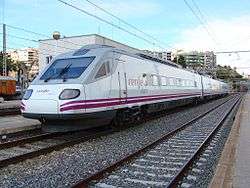Alaris
| Alaris | |
|---|---|
 | |
| Overview | |
| Locale | Madrid and Valencia, Spain |
| Operation | |
| Operator(s) | RENFE |
Alaris is the brand name of the regional rail network run by the Spanish national rail company Renfe Operadora that connects the major cities of Madrid and Valencia, and Barcelona and the main cities of the Valencian community. Alaris services currently use ETR 490 trainsets, as well as S-120 and S-130 units.
History
Midway through the 1990s, RENFE realised that needed to replace its old Talgo III trains which had run on the line for over thirty years. As a replacement, RENFE looked for new railcars that could run at high speeds on electric lines.
After searching throughout the ideas of multiple companies, RENFE chose a conglomeration of GEC Alsthom and FIAT Ferroviaria as the winners of a bid to develop new trains for the network titled ETR 490, similar to the ETR 470 trains used on the Italian Cisalpino network.
The new units were put into service on a new line between Madrid and Valencia via Albacete with emphasis on high speed, quality, and comfort. Although originally known as InterCity 2000, RENFE did not believe that the name was representative of the service, RENFE decided to rename the service "Alaris." RENFE then rebranded and repainted its trainsets and other publicity to show the new logo.

Service quality
Alaris is a medium/high profile rail service, very similar to aeroplanes business class, with stewardess, restaurant/snack bar, press service, personal multimedia stations, free automobile parking and baby sitter services. Alaris machines were manufactured by Fiat Ferroviaria and then by Alstom, and can maintain a moderate continuous speed of 200 km/h (120 mph).
Criticism
Despite its new and modern trains, higher focus on quality and speed, and modernity, Alaris has been criticised. Most critics point to a few main details where Alaris does not meet expectations.
- Alaris only has a thirteen-minute improvement over the previous train (InterCity UT-448) that used the system.
- There are only 160 seats on the new Alaris trains, while the InterCity UT-448 trains had 206 seats available in each car. This means that it takes less time for trains to be full and passengers must now make reservations beforehand to ensure that there is a seat available for them.
- Current prices for the Alaris are more expensive than those of the original rail service and features such as the BonoCity (four trips between Madrid and Valencia) have ceased to exist, therefore increasing the price that one must pay to use the service.
External links
| Wikimedia Commons has media related to Alaris. |
